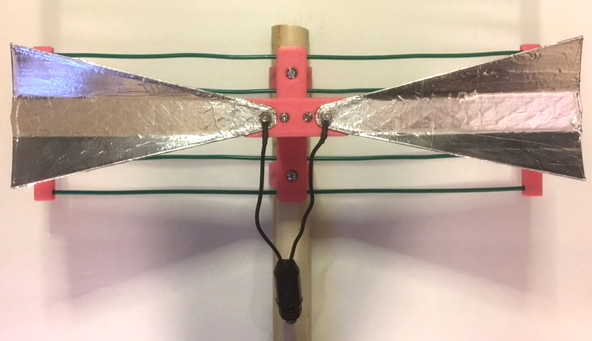
Another Small HDTV UHF antenna
thingiverse
This design draws inspiration from https://www.thingiverse.com/thing:1729860, which works surprisingly well. This variation is specifically designed to attach to a piece of 1" PVC pipe and facilitate easy stacking for enhanced signal strength. My own PVC pipe measures 1-5/16" in diameter. Two designs are included for the active elements. Design 1 features a V-shaped wire bent at approximately 30 degrees, with each side measuring about 7 inches (178mm) long. Begin by starting with about 16 inches (406mm) of wire and bend it in half. Then, spread out the wire and trim each side to the desired length. Use a washer on either side of the element. Design 2 is a classic bent bowtie that closely resembles the elements I recall from my time as an antenna installer. First, print the elements before covering them with foil. I used aluminum tape typically used for sealing air conditioning ductwork; you could also use a thin sheet of metal for the element. For either design, holes are included to enable multiple antennas to be stacked. While there isn't much difference in signal strength between two stacked antennas, stacking reduces dropouts due to nearby trains and airplanes. I found that the best performance was achieved with feedpoints on each antenna spaced about 7 inches apart. The clamps on the PVC pipe allow for easy adjustment of this spacing. The element holders attach to the center bracket using #6-32 screws, while the elements secure to their holder via #6-32 or #8-32 screws. Use washers around the element mounting screws to ensure electrical conductivity. The PVC clamps employ #10-24 hardware. The reflector elements should be of equal length, approximately 16 inches (406mm) long. While exact length is not crucial, the elements should all be close in length. Insert the elements into the center bracket about halfway. Place an end cap over each end of the wires. Friction should hold the elements in place; if there are any issues, a couple drops of super glue can secure them. You can also build this design with just the active element and mounting bracket without any reflectors. Option 1 - Wire antenna, no reflector 1 ea center bracket 1 ea center wire feed 2 ea PVC clamp 2 ea stiff wire, about 3 mm OD, 16" long Option 2 - Bowtie antenna, no reflector 1 ea center bracket 1 ea center bowtie feed 2 ea PVC clamp 2 ea bowtie elements Option 3 - Wire antenna, with reflector 1 ea center bracket 1 ea center wire feed 2 ea PVC clamp 2 ea reflector end 7 ea stiff wire, 3 mm OD, 16" long. This setup yields performance similar to the original design (1729860). Option 4 - Bowtie antenna, with reflector 1 ea center bracket 1 ea center bowtie feed 2 ea PVC clamp 2 ea bowtie elements 2 ea reflector end 7 piece stiff wire, 3 mm OD, 16" long To create stacked antennas, build two of the same option with an extra center feed. Insert the wires into the center feed at each antenna and connect the coax halfway between the two antennas. I utilized a hard plastic covered clothesline wire for the wire elements and reflectors due to its affordability and availability. The printer settings are likely not critical. I used: Printer - I3 clone Slicer - IdeaMaker Layer height - 0.2 mm Infill - 20% Cubic Walls - 4 Top/Bottom layers - 3
With this file you will be able to print Another Small HDTV UHF antenna with your 3D printer. Click on the button and save the file on your computer to work, edit or customize your design. You can also find more 3D designs for printers on Another Small HDTV UHF antenna.
